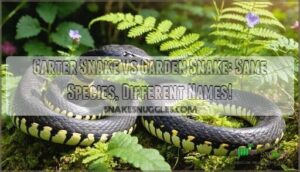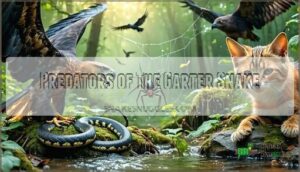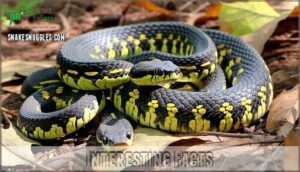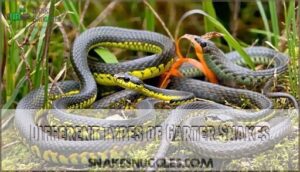This site is supported by our readers. We may earn a commission, at no cost to you, if you purchase through links.

"Garden snake" is simply a common mispronunciation or folk name that many people use. The correct name is "garter snake," which comes from their distinctive striped pattern resembling old-fashioned sock garters.
You’ll often hear both terms used interchangeably, but scientists and reptile experts prefer "garter snake." These harmless, beneficial reptiles are found throughout North America and actually help control pest populations in your yard.
While the naming confusion persists, understanding their true identity reveals fascinating details about their behavior and ecological importance.
Table Of Contents
- Key Takeaways
- Garter Snake Description & Range
- Habitat and Diet
- Predators of The Garter Snake
- Interesting Facts
- Different Types of Garter Snakes
- Garter Snake Bites and Their Impact
- Frequently Asked Questions (FAQs)
- Is a garter snake the same as a garden snake?
- What is another name for a garden snake?
- Are garden snakes and garter snakes found in the same habitats?
- How do garden snakes and garter snakes contribute to the ecosystem?
- Are garden snakes and garter snakes same species?
- Can you keep garden snakes as pets?
- How do you tell male from female?
- What time of year do they breed?
- Do garden snakes hibernate in winter months?
- Conclusion
Key Takeaways
- They’re identical species – Garden snake and garter snake refer to the exact same reptile, with "garden snake" being a common mispronunciation of "garter snake"
- You’ll recognize them by their stripes – These harmless snakes have distinctive longitudinal stripes in yellow, white, or green against dark bodies, measuring 18-54 inches long
- They’re beneficial for your yard – You’re actually looking at nature’s pest control squad that helps eliminate rodents, insects, and other unwanted garden pests
- You don’t need to fear them – These nonvenomous snakes rarely bite humans, and when they do, you’ll only experience minor swelling and irritation that disappears within 24 hours
Garter Snake Description & Range
You’ve likely encountered these slender reptiles without realizing garter snakes and garden snakes refer to the same species.
Physical Traits include distinctive longitudinal stripes in yellow, white, or green against dark bodies, measuring 18-54 inches long with keeled scales and slightly broader heads than necks.
Their Geographic Distribution spans North America from Canada to Central America, making them among the continent’s most widespread snakes.
Subspecies Variation includes Common, Western, Eastern, and Black-necked varieties, each adapted to specific regions.
These snake identification features help distinguish them from snake lookalikes.
Their remarkable Habitat Adaptations allow survival in woodlands, grasslands, marshes, and urban areas.
Most populations maintain stable Conservation Status, though some face localized habitat pressures from development.
However, mislabeling raises conservation concerns about vulnerable subspecies.
Habitat and Diet
These versatile snake-hunters thrive across diverse environments, from wetland meadows to Urban Habitats like suburban gardens. Their Water Dependence varies by location—some populations favor marshes while others adapt to drier areas.
You’ll find them in:
- Damp woodlands near streams and ponds
- Garden spaces with abundant insect populations
- Meadows and grasslands with seasonal water sources
Their Diet Adaptations reflect remarkable Prey Variety. Garter snakes consume insects, amphibians, earthworms, small fish, and occasionally bird eggs. This snake diet flexibility enables successful snake habitat colonization across North America.
Like the milk snake, garter snakes also contribute to ecological balance by controlling prey populations. During Seasonal Activity periods, they adjust feeding patterns—more active hunting in warmer months. This snake comparison shows how habitat shapes behavior, making the garden snake/garter snake equally at home in wild marshes or backyard gardens.
Predators of The Garter Snake
Garter snakes frequently face numerous predators throughout their lives, making survival a constant challenge.
From constant vigilance to swift escape, garter snakes live life perpetually hunted by predators above and below.
Avian predators pose the greatest threat, with birds of prey like hawks, owls, and crows actively hunting these snakes from above.
Mammalian threats include foxes, raccoons, skunks, and domestic cats that patrol ground-level territories where garter snakes hunt and bask.
Reptilian enemies such as larger snakes occasionally prey on smaller garter species, though this occurs less frequently.
Human impact affects snake predators indirectly through habitat destruction and vehicle strikes on roads.
Juvenile vulnerability remains particularly high since young snakes can’t defend themselves effectively against threats.
Even fish, frogs, and large spiders will attack baby garter snakes.
Eagles target juvenile garter snakes, similar to how they hunt boa constrictors.
When cornered, these snakes release foul-smelling musk and may bite defensively, but they’re generally more likely to flee quickly into dense vegetation or water where they can swim to safety from most terrestrial predators.
Interesting Facts
Behind these harmless North American snakes lies fascinating behavior you’ll find enchanting. Garter snakes use their chemosensory tongue to "taste" their environment, detecting prey and predators through chemical signals.
When threatened, they’ll release snake musk as defense while rarely biting. These Thamnophis species give live birth rather than laying eggs, producing up to 40 offspring.
Hognose snakes also use musk as a defense mechanism, and some even mimic cobra postures.
- Social basting: Groups gather on warm surfaces, sometimes forming "snake balls" during spring emergence from brumation behavior
- Seasonal adaptations: They brumate (hibernate) communally in underground dens, with hundreds sometimes sharing winter shelter
Different Types of Garter Snakes
Over 35 snake species belong to the Thamnophis genus, each showcasing unique subspecies variations and regional adaptations across North America.
You’ll find remarkable color morphs and identifying types that reflect their environments:
- Common Garter Snake (Thamnophis sirtalis) – North America’s most widespread snake species with yellow, green, or blue stripes
- Ribbon Snake (Thamnophis sauritus) – Slender bodies with exceptionally long tails for aquatic hunting
- Plains Garter Snake (Thamnophis radix) – Orange or yellow dorsal stripes bordered by distinctive dark spots
- Butler’s Garter Snake (Thamnophis butleri) – Great Lakes region specialist with narrow yellow back stripes
- Northwestern Garter Snake (Thamnophis ordinoides) – Pacific Northwest’s most variable North American snakes
These common snakes demonstrate how hybridization and geographic isolation create diverse snake types within a single genus.
The strikingly colored California red sided garter snake is another example of this diversity.
Garter Snake Bites and Their Impact
Worried about snake bites? You can breathe easy knowing that garter snake encounters rarely pose serious health risks. These nonvenomous snakes produce mild venom with extremely low potency – far weaker than what you’d find in truly dangerous species.
Rest easy – garter snake bites are nature’s gentlest warnings, posing no real danger to humans.
If you experience a garter snake bite, bite symptoms typically include minor swelling, redness, and mild itching that disappears within 24 hours. First aid involves simple wound cleaning with soap and water, followed by antiseptic application. Over-the-counter pain relievers handle any discomfort effectively.
Snake identification helps with bite prevention – recognizing garter snakes’ distinctive stripes reduces unnecessary panic. Snake safety means avoiding direct snake handling, but these creatures prefer escaping over confrontation anyway. While bites aren’t considered dangerous, their saliva contains a mild toxin that may cause localized irritation.
Long-term effects from garter snake bites remain virtually nonexistent in medical literature. Understanding proper snake safety transforms fear into appreciation. These beneficial reptiles control garden pests naturally, making them valuable neighbors rather than threats requiring elimination.
Frequently Asked Questions (FAQs)
Is a garter snake the same as a garden snake?
You’ll often hear "garden snake" and "garter snake" used interchangeably, but they’re actually the same creature.
"Garden snake" is simply a common nickname for garter snakes you’d spot in your yard.
What is another name for a garden snake?
You’ll often hear "garden snake" used as another name for the common garter snake.
Both terms describe the same harmless, striped reptiles you’d find slithering through your backyard or local park.
Are garden snakes and garter snakes found in the same habitats?
You’ll typically find both species in similar areas since they’re actually the same snake.
Garden snake is just a common nickname for garter snakes when they’re spotted in yards and gardens.
How do garden snakes and garter snakes contribute to the ecosystem?
You’ll find these species are nature’s pest control squad, keeping your gardens free from unwanted bugs and rodents while maintaining ecological balance through predator-prey relationships.
Are garden snakes and garter snakes same species?
You’ll find that "garden snake" and "garter snake" typically refer to the same species. Garden snake is just a common nickname for garter snakes you’d spot in yards and gardens.
Can you keep garden snakes as pets?
Like capturing a slippery fish in your hands, keeping garden snakes (garter snakes) as pets isn’t recommended.
They’re wild animals that need specific humidity, temperature, and diet requirements that’re difficult to replicate indoors, making them a less than ideal choice for a pet.
How do you tell male from female?
You’ll identify garter snake gender by examining tail characteristics.
Males have longer, more gradually tapering tails past the vent opening, while females show shorter, more abruptly tapering tails after their cloaca.
What time of year do they breed?
Garter snakes breed in spring when they emerge from hibernation, typically March through May.
You’ll see males pursuing females in mating balls, followed by live births in late summer after a 2-3 month gestation period.
Do garden snakes hibernate in winter months?
Yes, you’ll find garden snakes hibernating during winter months in underground burrows, rock crevices, or other sheltered locations. They enter a state called brumation, remaining dormant until spring temperatures return.
Conclusion
Remember finding your first snake in the garden and panicking because you couldn’t tell if it was dangerous. That moment of uncertainty affects thousands of people annually who encounter these striped reptiles.
Now you understand there’s no difference between a garden snake and a garter snake—they’re identical species with different names. Whether you call them garden snakes or garter snakes, you’re looking at North America’s most beneficial backyard reptile.
These harmless creatures control rodent populations while posing zero threat to humans. Next time someone asks what’s the difference between a garden snake and a garter snake, you’ll confidently explain they’re the same helpful species.










